Data Collection Systems (DCS) Platform Ceremony

16 January 2024
Credit From : Bernama
Links : https://www.bernama.com/en/business/news.php?id=2262906
Memorandum of Collaboration MPIA-BURSA Malaysia Signing Ceremony

16 January 2024
Credit From : Bernama
Links : https://www.bernama.com/en/news.php?id=2262991
Launch of MPIA Sarawak Chapter

07 September 2023
Credit From : The Borneo Post
MPIA Spreads wings to Sarawak

14 March 2023
Credit From : Borneo Post
MPIA launched the Data Collection System (DCS) Platform

15 December 2022
Credit From : Business Today

THERE has been a significant increase in the awareness and adoption of, as well as investor interest in, solar energy over the past decade. This can be seen from the launch of the feed-in tariff (FiT) in 2012 to the rollout of the first large-scale solar programme (LSS1) in 2017 and the introduction of the rooftop and power purchase agreement (PPA) models two years later.
For instance, the 300mw quota allocated to the Net Offset Virtual Aggregation (NOVA) programme under the existing Net Energy Metering programme (NEM 3.0) was fully taken up early last month by energy consumers, particularly those from the commercial and industrial sectors.
This is even more impressive when considering that the NOVA programme only commenced on April 1. Moreover, the uptake over the last three months has surpassed the total uptake in the first three years of the NEM programme, which commenced in 2016.
While Malaysia’s ambition to achieve carbon-neutral status by 2050 is backed by growing demand and an established value chain, as well as arguably one of the most comprehensive policies in the region for renewable energy (RE) development, especially for large-scale programmes, Malaysian Photovoltaic Industry Association (MPIA) president Davis Chong Chun Shiong warns that there are still bottlenecks that need to be dealt with immediately.
“The market demand for RE is growing. Malaysia should be looking at our energy policies in a more holistic way because the future trends of RE are going to impact not just the growth of RE players, but also many other industries as well. Unfortunately, we have some limitations and constraints in our existing policies,” he tells The Edge in a virtual interview.
According to Chong, the current government policies are limiting the country’s sustainable acceleration of RE, as the existing supply is not meeting the high demand. “Referring to the Report on Peninsular Malaysia Generation Development Plan 2020 (2021-2039), we would argue that the government policy is slowing the development of RE,” says the CEO of Solarvest Holdings Bhd, a Bursa Malaysia-listed solar turnkey engineering, procurement, construction and commissioning (EPCC) solution specialist, which is making its debut as an asset owner in the fourth cycle of the LSS.
“Today, the whole world is talking about carbon-neutral, net zero by 2050. But our country’s policy is limiting our pace and progress as it is only driving us to 31% RE capacity mix by 2025 and 40% RE mix by 2035. I think we can and we should do better than this.”
Established in 2006, MPIA is a non-profit organisation that represents the local solar industry. It has almost 150 members, including manufacturers, service providers, system integrators, consultants, insurance providers, training providers and academicians.
“We would like to urge the government to reassess the RE quota allocation as stated in the Peninsular Malaysia Generation Development Plan 2020. The current roadmap to reach 40% RE mix by 2035 includes the capacity for large hydrogen plants, which distorts the whole quota allocation,” Chong asserts.
In addition to the 5.2gw of operational and committed RE, Malaysia needs another 3.3gw of new RE requirements to reach the 31% RE mix target by 2025 (see bar chart). Of the 3.3gw, 2.2gw will be occupied by a large hydro segment which, in MPIA’s view, should be allocated to pure RE sources instead.
“The inclusion of large hydro in the RE roadmap is uncommon as it dilutes and limits the new capacity deployment for RE sources such as solar, mini hydro and biomass. The remaining 1.1gw new requirement of RE mix can easily be fulfilled even before 2025, given that one LSS and NEM programme can easily generate 1.5gw,” he explains.
Moving beyond 2025, Chong points out that only 2.4gw of new RE capacity will be required to reach 40% RE mix by 2035, which is not a difficult target to accomplish. Therefore, MPIA strongly believes that Malaysia’s RE roadmap should be more expansive to better reflect the demand for RE in the country.
Attractive solar policy could attract MNCs
Chong points out that there is strong demand from multinational corporations (MNCs) and RE100 companies, such as Facebook, Coca-Cola, Microsoft, Google and Amazon, for direct RE supply to be made available at their premises. RE100 is a global corporate RE initiative that brings together hundreds of large businesses committed to 100% renewable electricity.
“When we speak to these MNCs, they want to know about the availability of RE in our country. There should be more flexibility for RE trading such as P2P (peer-to-peer), direct PPA as well as third-party access to meet the rising demand,” he proposes, adding that MPIA is supportive of the imposition of fair grid fees as it believes commercial and industrial players are willing to pay.
“These MNCs are not in the energy business, but they want to get direct RE supply. If you allow third-party access, a lot of companies will be willing to do it. Of course, now you could buy a piece of land next to the MNC’s office and build a solar farm, but it is not feasible,” he observes.
“Let’s say if an MNC has a data centre in Kuala Lumpur, how can it build a solar farm in KL? It would make better sense for them to build it on cheap land in Terengganu or Kedah. That’s why third-party access to the grid is important — so they can operate an off-site virtual power plant.”
Chong opines that if the government allowed direct RE supply, Malaysia may not even need the LSS programme as everyone would be free to decide which power to consume. And the beauty of it is that the government could collect taxes while Tenaga Nasional Bhd could charge grid fees.
“All these MNCs and RE100 companies have set their own RE goals. They need to have their energy transition plans to meet their strategic directions. The best way is to get direct RE supply via off-site PPA, so I’m sure they will be very keen to become the off-takers of the RE plants,” he says.
Likewise, there are many RE investors out there who are willing to put up RE plants and sell the energy to these MNCs and Fortune 500 companies. “Basically, you have a willing buyer and a willing seller. You also have the infrastructure, but the policy is limiting your growth. While the limitation in our country’s RE policy will not directly block foreign investments, it is certainly not encouraging for them to come here compared with other countries that have more supportive policies,” says Chong.
ESG investment theme and solar hype
It has not gone unnoticed that Bursa Malaysia has been encouraging public-listed companies (PLCs) to adopt environmental, social and corporate governance (ESG) practices, particularly those with a larger market capitalisation even though there is no enforcement.
Chong believes the pressure of financial institutions and big foreign funds with strict guidelines to invest in companies that pass their sustainability framework will push more local companies to strive to meet these requirements lest they fall off the radar screens of ESG investors.
“For instance, a bank may set strict guidelines that it will not finance a coal-fired power plant. I think more PLCs will experience more pressure to make their operations as ESG-compliant as possible. But as it is, Malaysia is not progressing as fast,” he observes, but credits bigger corporations such as ViTrox Corp Bhd and Sunway Bhd with taking the lead in adopting RE.
“I think Bursa and the banks will play a very important role in the years to come. If you want to get your company listed, you need to meet Bursa’s requirements. If you want to borrow money from a bank, you need to accommodate certain criteria,” says Chong.
Although green energy stocks, including solar companies, are expected to be favoured by ESG investors, he is of the view that the whole value chain of the solar industry is much bigger than that. “I am talking about any company that is directly or indirectly involved in the green energy supply value chain, from energy generation to end users. Imagine if a financial institution is focusing on green loans by supporting environmentally sustainable economic activity, it should be deemed a green stock too,” he contends.
Nevertheless, Chong concedes that some companies may be only skimming the surface and riding the solar hype, rather than truly going green and sustainable. “If you look at Bursa-listed companies, there are not many pure solar players. Some companies are venturing into solar via LSS, but they are just asset owners. It really depends on the investors’ appetite, whether they want to go for asset-based companies or EPCC,” he says.
Given the increasing focus on ESG, companies that can claim some element of it will likely get more attention from investors and banks, whether it is fundraising or an impending listing, he adds. “For example, if you are selling a furniture product made from recycled wood, you may have an advantage over conventional furniture players when raising funds. The ESG will create a very good story for your company.”
However, there are many shades of green. For instance, solar may be considered RE, but certain quarters have highlighted that solar panels contain toxic chemicals and materials. Yet another looming issue is the disposal of solar panels and solar waste.
Chong acknowledges that the manufacturing process of solar panels is toxic and therefore, it is the manufacturers’ responsibility to take care of the scheduled waste. But he is quick to clarify that solar panels are essentially made of aluminium frame, glass and silicon, and hence, they are akin to electronic waste, which can be segregated and recycled.
“There is no way that we cannot recycle these types of waste. To us, these are just normal, solid waste, e-waste and metal waste. But yes, the solar panel manufacturers need to have their [own] recycling programme,” he says.
“When we were getting into the electronic era, did we plan the recycling programme? No. But in the end, businesses found that recycling e-waste is also a business opportunity that could generate income. We believe the same is going to happen in the solar industry. The waste recyclers will find ways to recycle solar panels.”
Chong points out that in some countries, the recycling cost is built into the tariff as solar farm operators are responsible for the waste. “At the moment, there aren’t many solar panel manufacturers providing recycling programmes. But I do believe they will do more in the future because this is their social responsibility. In any case, solar panels are generally a non-hazardous waste.”
17 August 2021
Credit From : The Edge
Links : https://www.theedgemarkets.com/article/mpia-urges-government-reassess-re-quota-allocation
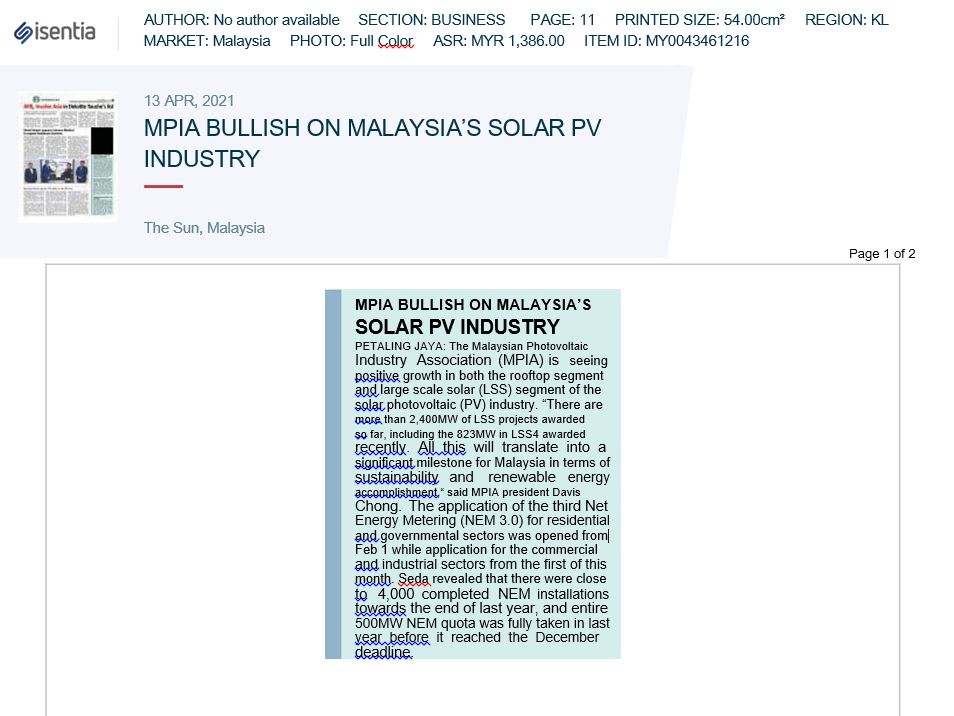
13 April 2021
Credit to : The Sun
New MPIA committee to lead the local solar PV industry
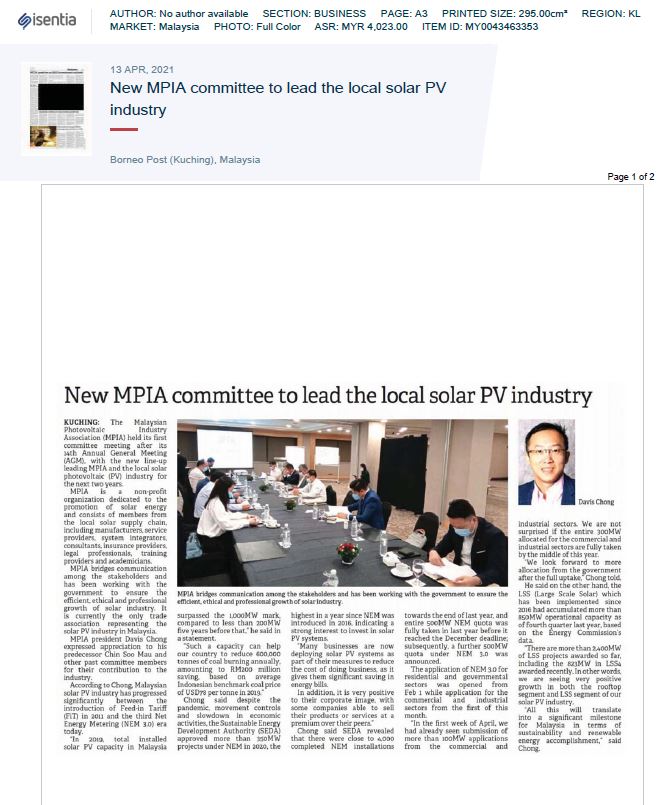
13th April 2021
Credit to : Borneo
MPIA sees positive growth in solar PV industry, expects more NEM quota allocation



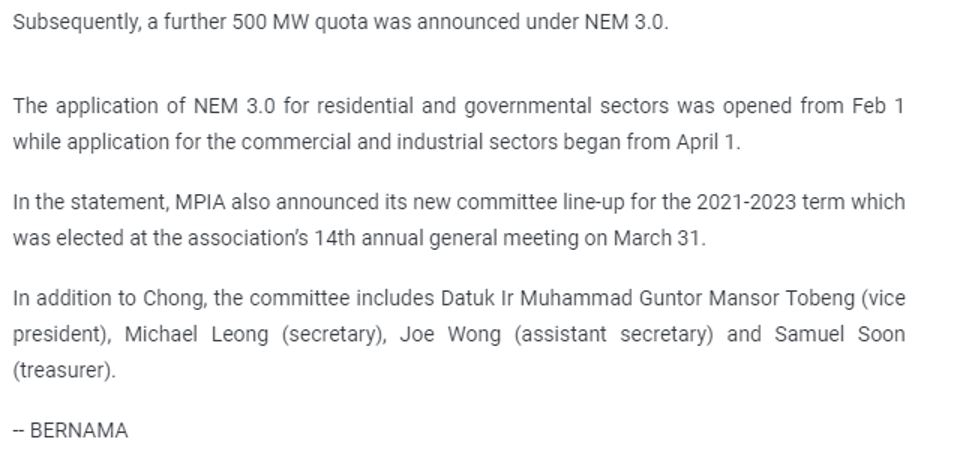
12th April 2021
Credit to : Bernama
Link : https://www.bernama.com/en/business/news.php?id=1951367
MPIA jangka lebih banyak peruntukan kuota di keluarkan untuk industri solar PV




12th April 2021
Credit to : Bernama
Link : https://www.bernama.com/bm/ekonomi/news.php?id=1951414
MPIA jangka lebih banyak peruntukan kuota di keluarkan untuk industri solar PV

KUALA LUMPUR – Malaysia sedang menyaksikan ‘pertumbuhan yang sangat positif’ dalam segmen solar atas bumbung dan ladang solar berskala besar (LSS) industri solar fotovoltan negara, menurut Persatuan Perusahaan Industri Fotovolta Malaysia (MPIA).
Presiden MPIA, Davis Chong berkata, lebih 2,400 megawatt (MW) projek LSS telah dianugerahkan setakat ini termasuk 823 MW dalam pakej LSS (LSS4) keempat yang disampaikan baru-baru ini.
Pada minggu pertama April, lebih daripada 100 permohonan MW telah dikemukakan oleh sektor komersial dan perindustrian.
“Kami tidak akan terkejut jika kesemua 300 MW yang diperuntukkan untuk sektor komersial dan perindustrian diambil sepenuhnya menjelang pertengahan tahun ini. Kami menantikan lebih banyak peruntukan daripada kerajaan selepas pengambilan penuh tersebut,” katanya dalam satu kenyataan pada Isnin.
Davis berkata, pertumbuhan itu boleh diterjemahkan ke dalam pencapaian terpenting bagi Malaysia daripada segi pencapaian kemampanan dan tenaga boleh diperbaharui.
“Banyak perniagaan kini menggunakan sistem solar fotovoltan (PV) sebagai sebahagian daripada langkah mereka untuk mengurangkan kos menjalankan perniagaan kerana ia memberi mereka penjimatan yang ketara dalam bil tenaga.
“Selain itu, ia sangat positif kepada imej korporat mereka, dengan beberapa syarikat dapat menjual produk atau perkhidmatan mereka pada premium berbanding saingan mereka,” katanya.
Beliau berkata, Pihak Berkuasa Pembangunan Tenaga Lestari (SEDA) mengumumkan bahawa hampir 4,000 pemasangan pemeteran tenaga bersih (NEM) telah selesai menjelang akhir tahun lepas dan keseluruhan kuota 500 MW NEM di bawah program NEM 2.0 telah diambil sepenuhnya sebelum tarikh akhir 31 Dis 2020.
Seterusnya, tambahan kuota 500 MW telah diumumkan di bawah NEM 3.0.
Permohonan NEM 3.0 untuk sektor kediaman dan kerajaan dibuka mulai 1 Feb manakala permohonan bagi sektor komersial dan perindustrian bermula 1 April.
MPIA dalam kenyataan itu, turut mengumumkan barisan jawatankuasa baharunya untuk penggal 2021-2023 yang dipilih pada mesyuarat agung tahunan persatuan yang ke-14 semasa 31 Mac lalu. Selain Davis, jawatankuasa itu merangkumi Datuk Ir Muhammad Guntor Mansor Tobeng (naib presiden), Michael Leong (setiausaha), Joe Wong (penolong setiausaha) dan Samuel Soon (bendahari). – Bernama
12th April 2021
Credit to : Sinar Harian
Malaysia’s solar PV industry poised for robust growth trajectory

THE strong interest to invest in solar photovoltaics (PV) systems in Malaysia has continued unabated with the Sustainable Energy Development Authority (SEDA) having approved more than 350 megawatt (MW) of projects under net energy metering (NEM) initiative in 2020 – the highest in a year since NEM was introduced in 2016.
Even amid the COVID-19 pandemic outbreak, movement controls and slowdown in economic activities, SEDA revealed that there were close to 4,000 completed NEM installations towards end-2020 with the entire 500MW NEM quota fully taken up before it reached the December deadline.

On the other hand, Chong said the large scale solar (LSS) which has been implemented since 2016 had accumulated more than 850MW operational capacity as of 4Q 2020 based on the Energy Commission’s data.
“There are more than 2,400MW of LSS projects awarded so far, including the 823MW in LSS4 awarded recently,” the group CEO of Solarvest Holdings Bhd pointed out.
“In other words, we are seeing very positive growth in both the rooftop segment and LSS segment of our solar PV industry. All this will translate into a significant milestone for Malaysia in terms of sustainability and renewable energy accomplishment.”
According to Chong, Malaysian solar PV industry has progressed significantly between the introduction of Feed-in Tariff (FiT) in 2011 and the NEM 3.0 era today.
In 2019, total installed solar PV capacity in Malaysia surpassed the 1,000MW mark compared to less than 200MW five years before that.
“Such a capacity can help our country to reduce 600,000 tonnes of coal burning annually, amounting to RM200 mil saving based on average Indonesian benchmark coal price of US$78 per tonne in 2019,” he enthused.
Chong who succeeded Chin Soo Mau as the MPIA president and his team will lead MPIA and the local solar PV industry for the next two years.
Established in year 2006 as an initiative under the Ministry of Energy, Water and Communications, MPIA is a non-profit organisation dedicated to the promotion of solar
energy and consists of members from the local solar supply chain, including manufacturers, service providers, system integrators, consultants, insurance providers, legal professionals, training providers and academicians. – April 12, 2021
12th April 2021
Credit to : Focus Malaysia
Links : https://focusmalaysia.my/malaysias-solar-pv-industry-poised-for-robust-growth-trajectory/
MPIA’s new committee 2021 – 2023
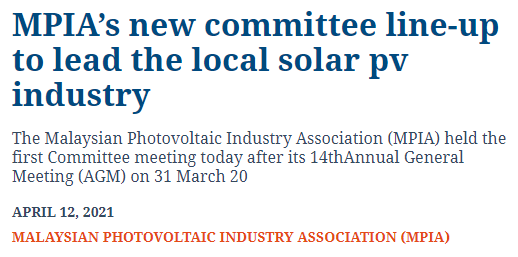
The Malaysian Photovoltaic Industry Association (MPIA) held the first Committee meeting today after its 14th Annual General Meeting (AGM) on 31 March 2021, which elected the new Committee line-up for term 2021-2023 as follows:
President : Mr Davis Chong, Atlantic Blue Sdn Bhd
Vice President : Dato’ Ir. Muhamad Guntor Mansor Tobeng, Gading Kencana Sdn Bhd
Secretary : Mr Michael Leong, Tera VA Sdn Bhd
Assistant Secretary : Mr Joe Wong, Times-Lite Electrical Engineering Sdn Bhd
Treasurer : Mr Samuel Soon, Anora Agency Sdn Bhd
Ordinary Committee Members:
Mr David Khoo Tah Wei, Selangor Human Resource Development Centre
Mr Justin Sim, North Consult Engineering Sdn Bhd
Mr Yohannes Yeremia, Longi (Kuching) Sdn Bhd
Ms Irene Tan Ai Peng, BSL Eco Energy Sdn Bhd
Mr Edmund Loo Chun Keat, Leveragedge Sdn Bhd
The AGM also appointed two internal auditors from among the members.
1. Ir. Prakash Sothivadivel, Petronas Power Sdn Bhd
2. Mr Izwan Rasul, Leader Solar Energy Sdn Bhd
The new committee will be leading MPIA and the local solar photovoltaic (PV) industry for the next two years.
Initiated by the Ministry of Energy, Water and Communications to have an industry voice and established in year 2006, MPIA is a non-profit organization dedicated to the promotion of solar energy and consists of members from the local solar supply chain, including manufacturers, service providers, system integrators, consultants, insurance providers, legal professionals, training providers and academicians.
MPIA bridges communication among the stakeholders and has been working with the government to ensure the efficient, ethical and professional growth of solar industry. It is currently the only trade association representing the solar PV industry in Malaysia. There are currently more than 130 members in MPIA, compared to less than 20 members when it was first established; this is a testimony to the growth of the local solar PV industry.
MPIA President Davis Chong expressed appreciation to his predecessor Chin Soo Mau and other past committee members for their contribution to the industry.
According to Chong, Malaysian solar PV industry has progressed significantly between the introduction of Feed-in Tariff (FiT) in 2011 and the third Net Energy Metering (NEM 3.0) era today.
“In 2019, total installed solar PV capacity in Malaysia surpassed the 1,000 MW mark, compared to less than 200 MW five years before that. Such a capacity can help our country to reduce 600,000 tonnes of coal burning annually, amounting to RM200 million saving, based on average Indonesian benchmark coal price of USD78 per tonne in 2019.”
Chong said despite the pandemic, movement controls and slowdown in economic activities, the Sustainable Energy Development Authority (SEDA) approved more than 350 MW projects under NEM in 2020, the highest in a year since NEM was introduced in 2016, indicating a strong interest to invest in solar PV systems.
“Many businesses are now deploying solar PV systems as part of their measures to reduce the cost of doing business, as it gives them significant saving in energy bills. In addition, it is very positive to their corporate image, with some companies able to sell their products or services at a premium over their peers.”
Chong said SEDA revealed that there were close to 4,000 completed NEM installations towards the end of last year, and entire 500 MW NEM quota was fully taken in last year before it reached the December deadline; subsequently, a further 500 MW quota under NEM 3.0 was announced.
The application of NEM 3.0 for residential and governmental sectors was opened from 1 February while application for the commercial and industrial sectors from the first of this month.
“In the first week of April, we had already seen submission of more than 100 MW applications from the commercial and industrial sectors. We are not surprised if the entire 300 MW allocated for the commercial and industrial sectors are fully taken by the middle of this year. We look forward to more allocation from the government after the full uptake,” Chong told.
He said on the other hand, the LSS (Large Scale Solar) which has been implemented since 2016 had accumulated more than 850 MW operational capacity as of fourth quarter last year, based on the Energy Commission’s data.
“There are more than 2,400 MW of LSS projects awarded so far, including the 823 MW in LSS4 awarded recently. In other words, we are seeing very positive growth in both the rooftop segment and LSS segment of our solar PV industry. All this will translate into a significant milestone for Malaysia in terms of sustainability and renewable energy accomplishment,” said Chong.
12th April 2021
Credit to : PV Magazine International
MPIA’s new committee 2021 – 2023

The Association of the Malaysian Photovoltaic Industry (MPIA) held the first committee meeting today after its 14th annual general meeting on March 31, 2021, in which the new committee list for the 2021-2023 term of office was elected as follows:
President: Mr. Davis Chong, Atlantic Blue Sdn Bhd
Vice President: Dato ‘Ir. Muhamad Guntor Mansor Tobeng, Gading Kencana Sdn Bhd
Secretary: Mr. Michael Leong, Tera VA Sdn Bhd
Deputy Secretary: Joe Wong, Times-Lite Electrical Engineering Sdn Bhd
Treasurer: Mr. Samuel Soon, Anora Agency Sdn Bhd
Ordinary committee members:
Mr. David Khoo Tah Wei, Selangor Personnel Development Center
Mr. Justin Sim, North Consult Engineering Sdn Bhd
Mr. Yohannes Yeremia, Longi (Kuching) Sdn Bhd
Ms. Irene Tan Ai Peng, BSL Eco Energy Sdn Bhd
Mr. Edmund Loo Chun Keat, Leveragedge Sdn Bhd
The general meeting also appointed two internal auditors from among the members.
1. Ir. Prakash Sothivadivel, Petronas Power Sdn Bhd
2. Mr. Izwan Rasul, Head of Solar Energy Sdn Bhd
The new committee will lead MPIA and the local solar photovoltaic (PV) industry for the next two years.
MPIA was launched by the Ministry of Energy, Water and Communications to have a voice for industry and founded in 2006. MPIA is a not-for-profit organization dedicated to the advancement of solar energy and composed of members of the local solar supply chain including manufacturers and service providers, system integrators, consultants, insurers, lawyers, training providers and academics.
MPIA connects the communication between stakeholders and has worked with the government to ensure efficient, ethical and professional growth of the solar industry. It is currently the only trade association representing the solar PV industry in Malaysia. There are currently more than 130 members in MPIA, compared to fewer than 20 members when it was founded. This is evidence of the growth of the local solar PV industry.
MPIA President Davis Chong thanked his predecessor Chin Soo Mau and other past committee members for their contribution to the industry.
According to Chong, the Malaysian solar PV industry has developed significantly between the introduction of the feed-in tariff (FiT) in 2011 and the third era of net energy metering (NEM 3.0) today.
“In 2019, the total installed solar PV capacity in Malaysia exceeded the 1,000 MW mark, compared to less than 200 MW five years earlier. Such a capacity can help our country reduce 600,000 tons of coal per year, which is a saving of RM 200 million based on the average Indonesian reference coal price of USD 78 per ton in 2019. “
Chong said that despite the pandemic, movement control and slowdown in economic activity, the Sustainable Energy Development Agency (SEDA) approved more than 350 MW projects under NEM in 2020. This is the highest figure since the introduction of NEM in 2016, which indicates a strong interest in investing in solar systems.
“Many companies are now using solar PV systems as part of their efforts to reduce business costs as they can make significant savings in energy bills. In addition, this has a very positive effect on the corporate image, as some companies can sell their products or services at a premium to their competitors. “
According to Chong, SEDA announced that nearly 4,000 NEM plants were completed late last year and the entire NEM quota of 500 MW was fully exhausted last year before the December deadline was reached. A further 500 MW quota was then announced as part of NEM 3.0.
The application of NEM 3.0 for residential and government sectors was opened from February 1st, while the application for the commercial and industrial sector was opened from the 1st of this month.
“In the first week of April we submitted more than 100 MW applications from the commercial and industrial sectors. We are not surprised if the entire 300 MW provided to the commercial and industrial sectors is fully utilized by the middle of this year. We look forward to another government allocation after the full takeover, ”said Chong.
On the other hand, the LSS (Large Scale Solar), which has been implemented since 2016, accumulated an operating capacity of more than 850 MW in the fourth quarter of last year on the basis of data from the Energy Commission.
“To date, more than 2,400 MW LSS projects have been awarded, including the recently awarded 823 MW in LSS4. In other words, we see very positive growth in both the roof and LSS segments of our solar PV industry. All of this will mark a major milestone for Malaysia in terms of sustainability and renewable energy achievement, ”said Chong.
12th April 2021
Credit to : Heating News Journal
Malaysia’s solar PV industry poised for robust growth trajectory
THE strong interest to invest in solar photovoltaics (PV) systems in Malaysia has continued unabated with the Sustainable Energy Development Authority (SEDA) having approved more than 350 megawatt (MW) of projects under net energy metering (NEM) initiative in 2020 – the highest in a year since NEM was introduced in 2016.
Even amid the COVID-19 pandemic outbreak, movement controls and slowdown in economic activities, SEDA revealed that there were close to 4,000 completed NEM installations towards end-2020 with the entire 500MW NEM quota fully taken up before it reached the December deadline.
On the other hand, Chong said the large scale solar (LSS) which has been implemented since 2016 had accumulated more than 850MW operational capacity as of 4Q 2020 based on the Energy Commission’s data.
“There are more than 2,400MW of LSS projects awarded so far, including the 823MW in LSS4 awarded recently,” the group CEO of Solarvest Holdings Bhd pointed out.
“In other words, we are seeing very positive growth in both the rooftop segment and LSS segment of our solar PV industry. All this will translate into a significant milestone for Malaysia in terms of sustainability and renewable energy accomplishment.”
According to Chong, Malaysian solar PV industry has progressed significantly between the introduction of Feed-in Tariff (FiT) in 2011 and the NEM 3.0 era today.
In 2019, total installed solar PV capacity in Malaysia surpassed the 1,000MW mark compared to less than 200MW five years before that.
“Such a capacity can help our country to reduce 600,000 tonnes of coal burning annually, amounting to RM200 mil saving based on average Indonesian benchmark coal price of US$78 per tonne in 2019,” he enthused.
Chong who succeeded Chin Soo Mau as the MPIA president and his team will lead MPIA and the local solar PV industry for the next two years.
Established in year 2006 as an initiative under the Ministry of Energy, Water and Communications, MPIA is a non-profit organisation dedicated to the promotion of solar
energy and consists of members from the local solar supply chain, including manufacturers, service providers, system integrators, consultants, insurance providers, legal professionals, training providers and academicians. – April 12, 2021
14th April 2021
Credit to : Focus Malaysia
Link : https://focusmalaysia.my/malaysias-solar-pv-industry-poised-for-robust-growth-trajectory/
MPIA Solar Roadshow 2020 – 2021







06 October 2020
Credit to : sinchew
Link : https://www.sinchew.com.my/?p=3103653
MPIA in The Star

18th September 2020
Credit to : The Star
MPIA Solar Roadshow 2020-2021 in Selangor
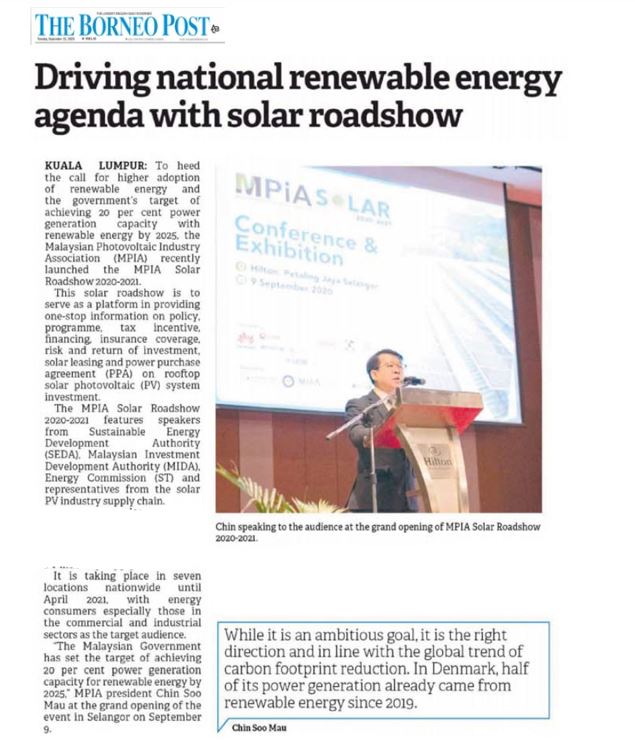
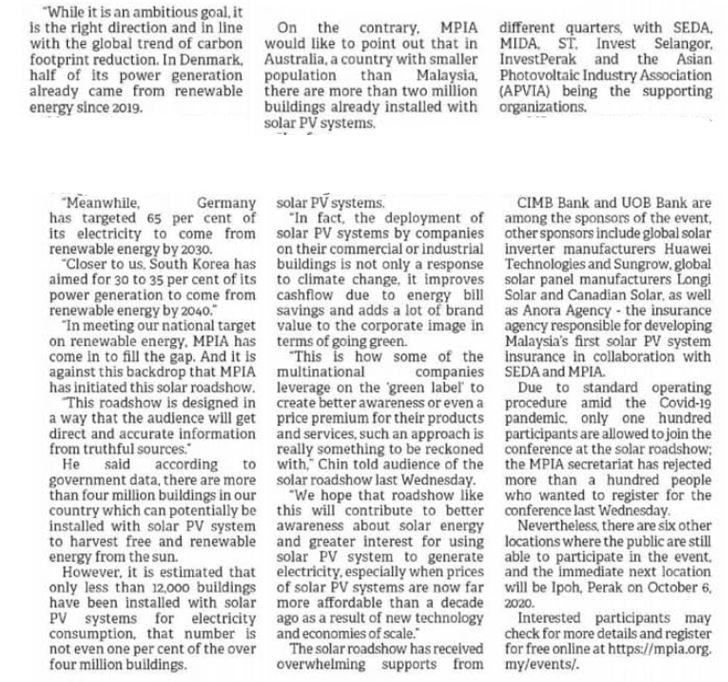
15th April 2020
Credit to : Borneo
Link : https://www.pressreader.com/malaysia/the-borneo-post-sabah/20200915/282260962880880
MPIA in New Straits Times

15th September 2020
Credit to : New Straits Times
MPIA Solar Roadshow 2020-2021 in Selangor
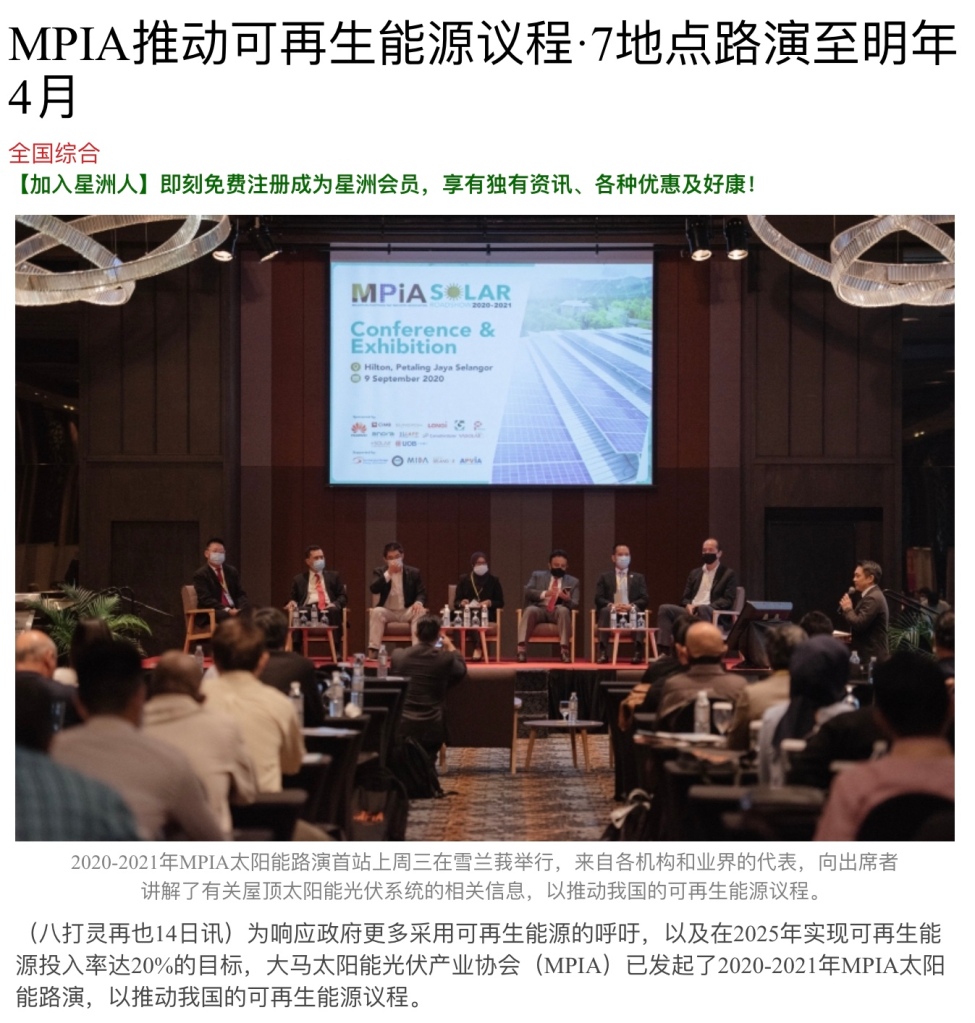
14th September 2020
Sin Chew Daily
Link: https://www.sinchew.com.my/content/content_2342596.html
MPIA Solar Roadshow 2020-2021 in Selangor

14th September 2020
Bernama
Link: https://www.bernama.com/bm/ekonomi/news.php?id=1879585
MPIA Solar Roadshow 2020-2021 in Selangor

14th September 2020
SolarQuarter
Link: https://solarquarter.com/2020/09/14/driving-national-renewable-energy-agenda-with-solar-roadshow/
MPIA in TheEdge
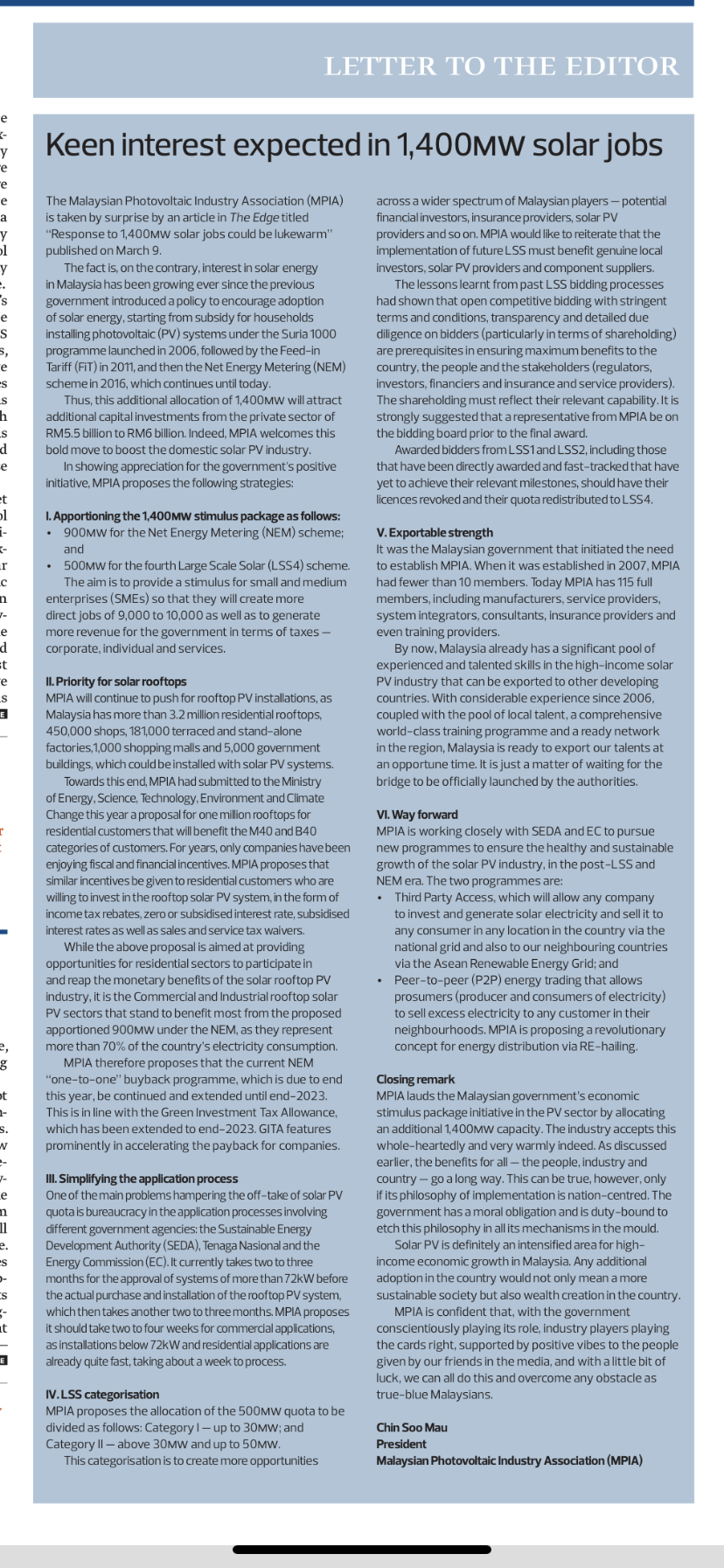
ASEAN Smart Grid Congress 2019

4th December 2019
Sin Chew Daily
Link: https://www.sinchew.com.my/content/content_2156827.html
ASEAN Smart Grid Congress 2019
4th December 2019
China Press Malaysia

Link: http://johor.chinapress.com.my/?p=722789
ASEAN Smart Grid Congress 2019
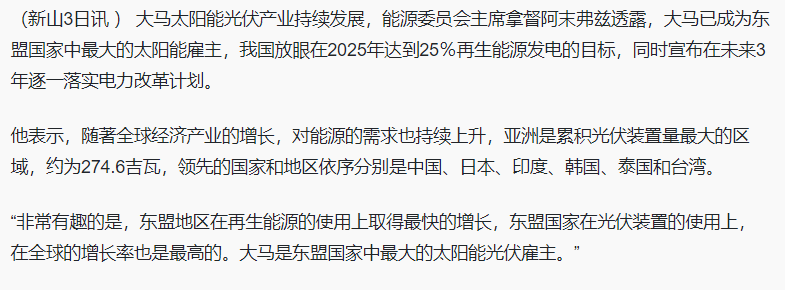
3rd December 2019
Oriental Daily
Link: https://www.orientaldaily.com.my/news/nation/2019/12/03/317285
MPIA Solar National Roadshow in Johor Bahru
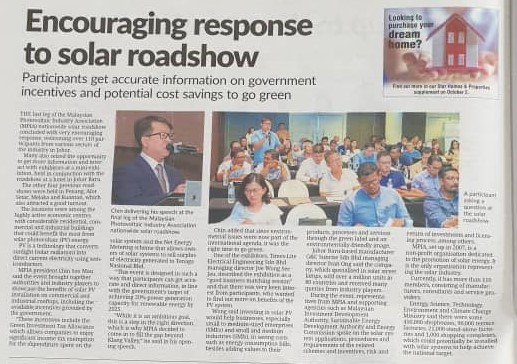
30th September 2019
The Star Newspaper
Encouraging Response to Solar Roadshow
Link: https://www.thestar.com.my/metro/metro-news/2019/09/30/encouraging-response-to-solar-roadshow
MPIA Solar National Roadshow in Kuantan
20th August 2019
China Press Malaysia

Link: https://bit.ly/2mk7YsB
Register for Solar National Roadshow 2019 at: http://bit.ly/solarroadshow
MPIA Solar National Roadshow in Kuantan

24th August 2019
The Star Newspaper
Malaysia has the potential to become a hub for solar photovoltaic (PV) system and application service providers.
Register for Solar National Roadshow 2019 at: http://bit.ly/solarroadshow
Solar Energy Courses, Training The Technicians

9th May 2019
SinChew Newspaper
MPIA and SHRDC are working together to organize solar energy courses for the training to technicians.
More details can also get from our upcoming Solar National Roadshow 2019.
Link: https://bit.ly/30FxDfe
Register for Solar National Roadshow 2019 at: http://bit.ly/solarroadshow
